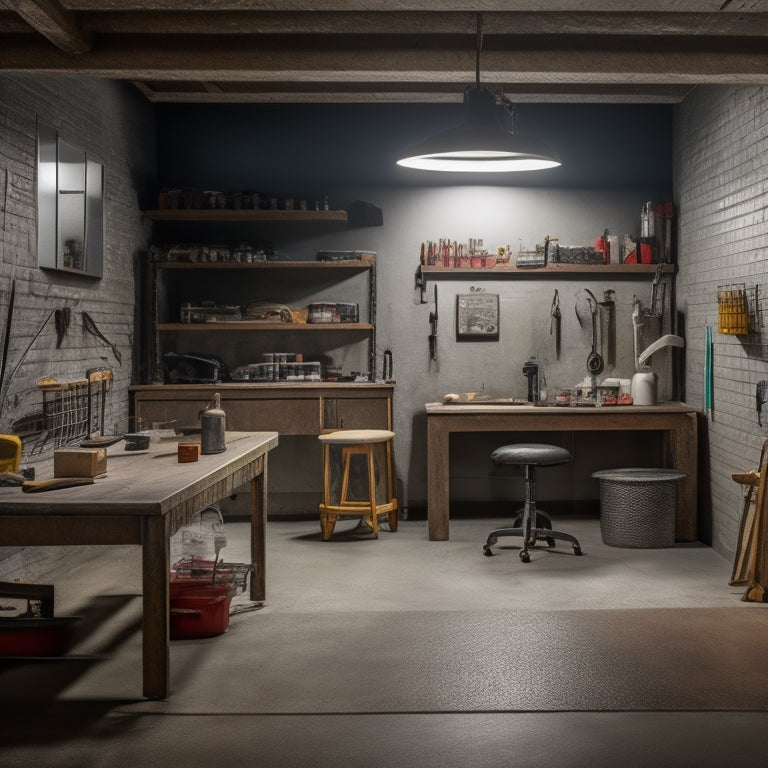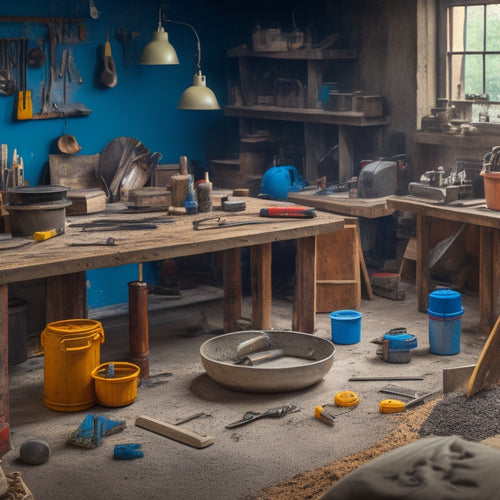
Must-Have Tools for Sealing Your Concrete Basement
Share
To guarantee a successful concrete basement sealing project, you'll need a range of specialized tools. Start with surface cleaning and preparation tools like pressure washers, wire brushes, and degreasers to create a strong bond between old concrete and new sealant. Next, gather applicator tools like sealant application guns and roller extension poles for even coverage. Measure and mix your sealant accurately with cups, buckets, and ratio scales. Don't forget protective gear like safety goggles, gloves, and respirator masks to safeguard your health. Finally, invest in surface preparation machines and post-application inspection tools to ensure a flawless finish - and that's just the beginning of what you'll need to know to get the job done right.
Key Takeaways
• Ensure thorough surface cleaning and preparation to create a strong bond between old concrete and new sealant.
• Use the right applicator tools, such as sealant application guns and roller extension poles, for precision and control.
• Accurate measuring and mixing equipment, including measuring cups, mixing buckets, and ratio scales, are critical for a strong seal.
• Wear protective gear, including safety goggles, gloves, and respirator masks, to prevent skin contact and inhalation of chemicals.
• Invest in surface preparation machines, such as floor scrapers, concrete grinders, and edge grinders, to achieve a smooth and even surface.
Cleaning and Preparing Surfaces
Before applying any sealant, thoroughly clean and prepare the concrete basement surfaces to confirm a strong bond between the old concrete and the new sealant.
You'll need to remove dirt, grime, and efflorescence (a white, powdery substance) from the surface. Effective surface cleaning techniques involve using a pressure washer, wire brush, or scrub brush to remove stubborn contaminants.
For more thorough cleaning, consider using a degreaser or acid-based cleaner to etch the surface. However, always follow the manufacturer's instructions and take necessary safety precautions.
Next, conduct a basement moisture assessment to identify any dampness or water seepage issues. Check for signs of water damage, cracks, or efflorescence on walls and floors.
You may need to address underlying moisture issues before applying a sealant. Ascertain the surface is dry and free of any standing water before proceeding.
Applicator Tools for Sealants
When it comes to applying sealants to your concrete basement, you'll need the right tools to get the job done efficiently and effectively.
You'll be working with various sealant materials, and that's where applicator tools come in - they'll help you achieve a professional-looking finish.
In your toolkit, you should have a sealant application gun and a roller extension pole to guarantee a smooth, even application.
Sealant Application Guns
You'll need a reliable sealant application gun to efficiently and effectively dispense sealants into the smallest crevices and cracks in your concrete basement. This tool is essential for achieving a professional-looking finish and guaranteeing a long-lasting seal.
When choosing a sealant application gun, consider the type of sealant you're using, as different guns are designed for specific sealant types. For example, a gun with a high-pressure output is ideal for thicker, more viscous sealants, while a low-pressure gun is better suited for thinner, more watery sealants.
When it comes to application techniques, a sealant application gun offers more precision and control than manual application methods. By adjusting the gun's output and nozzle angle, you can tailor the sealant flow to the specific crack or crevice you're filling.
This guarantees a smooth, even coat that fully seals the area without excess sealant waste. With the right sealant application gun and technique, you'll be able to achieve a professional-grade seal that protects your concrete basement from water damage and other issues.
Roller Extension Poles
With the precision of a sealant application gun in hand, you can now turn your attention to applying sealants to larger areas with a roller extension pole. This allows for efficient and even coverage of your concrete basement's walls and floors.
This versatile tool is designed to extend your reach, saving you time and effort when sealing large surfaces. When selecting a roller extension pole, consider the type of roller you need, such as a foam roller for textured surfaces or a microfiber roller for smooth surfaces.
Additionally, think about the extension length you require, as poles can range from 4 to 12 feet in length. A longer extension length provides greater reach, but may be more difficult to maneuver in tight spaces. A shorter extension length offers more control, but may require more strokes to cover the same area.
Measuring and Mixing Equipment
When it comes to measuring and mixing equipment, you'll need to get it right to guarantee a successful sealant application.
You'll be working with precise ratios and quantities, so it's crucial to have accurate measuring cups and a reliable mixing bucket on hand.
Accurate Measuring Cups
Accurate measuring cups guarantee that the correct ratios of cement, sand, and water are mixed together to achieve a strong and durable concrete seal.
When sealing your concrete basement, it's essential to get the measurements right to avoid a weak or brittle seal. You can't rely on guesswork or rough estimates, as this can lead to costly mistakes and a compromised seal.
To maintain accuracy, you'll need measuring cups made from durable, easy-to-clean materials like stainless steel or BPA-free plastic. Look for cups with clear markings and incremental measurements to make it easy to measure ingredients precisely.
Here are some key features to take into account:
-
Gradations: Opt for cups with clear, easy-to-read gradations to guarantee precise measurements.
-
Material: Choose cups made from durable, easy-to-clean materials like stainless steel or BPA-free plastic.
-
Capacity: Select cups with a capacity that suits your project needs, from small to large.
- Ergonomic design: Take into account cups with comfortable, ergonomic handles to reduce fatigue and improve handling.
Mixing Bucket Essentials
You'll need a sturdy, reliable mixing bucket to combine and blend the concrete sealing mixture, ensuring a consistent and strong bond. A bucket that can withstand the rigors of mixing and blending is essential to achieving a professional-looking finish.
When selecting a mixing bucket, consider the materials used in its construction. A heavy-duty, five-gallon bucket made from high-quality polypropylene or steel is ideal. These materials can withstand the weight and abrasion of the concrete mixture, ensuring the bucket remains intact throughout the mixing process.
When it comes to mixing techniques, a bucket with a non-slip handle and a flat, wide bottom is vital. This design allows for efficient mixing and blending, reducing the risk of lumps and ensuring a smooth, even consistency.
Look for a bucket with measurement markings to help you accurately gauge the amount of mixture. A bucket with a pour spout or lip is also a valuable feature, making it easy to transfer the mixture to the application area without spills or messes.
Proper Ratio Scales
With precise measurements crucial to achieving the best concrete seal, a reliable ratio scale is essential for accurately mixing and blending the sealant components. You can't afford to compromise on ratio accuracy, as it directly impacts the performance and durability of the seal. A high-quality ratio scale guarantees that you're mixing the exact proportions of sealant, hardener, and solvent, every time.
When selecting a ratio scale, consider the following key factors:
-
Scale calibration: Look for a scale that can be easily calibrated to guarantee accuracy and precision.
-
Resolution and readability: Opt for a scale with a high resolution (e.g., 0.01g or 0.1oz) and clear, easy-to-read displays.
-
Capacity and range: Choose a scale that can handle the weight range you need, from small batches to larger quantities.
- Durability and build: Select a scale built with durable materials that can withstand regular use and cleaning.
Protective Gear and Accessories
Sealing a concrete basement requires wearing protective gear and accessories to prevent injuries and guarantee a successful application. You don't want to risk your health or compromise the quality of your work. As you prepare to seal your concrete basement, make certain you have the necessary protective gear and accessories.
First, you'll need safety goggles to protect your eyes from chemical splashes and debris. Look for goggles with anti-fog lenses and a snug fit to ensure maximum protection.
Next, invest in a good pair of protective gloves. You'll want gloves that are resistant to chemicals, abrasion, and punctures. They should also provide grip and dexterity to handle tools and materials comfortably.
Additionally, consider wearing a respirator mask, a long-sleeved shirt, and pants to prevent skin contact and inhalation of harmful substances.
Don't forget a hat and steel-toed boots to complete your protective ensemble.
Surface Preparation Machines
Three essential surface preparation machines are required to adequately prepare your concrete basement floor for sealing. These machines will help you achieve a smooth, even surface that's ready for the sealant.
You'll need the following machines to get the job done:
-
Floor scraper: A floor scraper is used to remove old adhesives, paint, and other substances that may be stuck to the concrete floor. This machine is vital for creating a clean surface.
-
Concrete grinder: A concrete grinder is used to smooth out the floor and remove any imperfections. This machine is a must-have for achieving a uniform surface.
-
Edge grinder: An edge grinder is used to smooth out the edges and corners of the floor where the concrete grinder can't reach. This machine is perfect for getting into tight spaces.
- Vacuum: A vacuum is used to remove any dust and debris left behind by the other machines. This is an important step in surface preparation techniques, as a clean floor is crucial for a successful seal.
Remember to follow proper equipment maintenance procedures to guarantee your machines are in top condition.
Regular maintenance will help extend the life of your machines and guarantee they continue to perform at their best.
Post-Application Inspection Tools
Inspect your freshly sealed concrete basement floor using specialized tools to confirm a flawless finish and identify any potential issues early on. Post-application inspection tools are essential in verifying the quality of your sealant job.
You'll need a moisture meter to detect any underlying moisture issues that could compromise the sealant's adhesion. This is especially important in areas prone to water seepage or high humidity. Conduct moisture testing to determine the moisture level of the concrete, which will help you identify potential problem areas.
For surface analysis, use a UV light to inspect the sealed surface for any imperfections or defects. This tool will help you detect even the slightest flaws, allowing you to make adjustments before they become major issues.
Additionally, a laser level can come in handy to check the floor's elevation and verify it's even and level. By investing in these post-application inspection tools, you'll be able to identify and address any issues promptly, saving you time, money, and potential headaches down the line.
With the right tools, you can rest easy that your sealed concrete basement floor will look great and last for years to come.
Frequently Asked Questions
How Long Does It Take for Concrete Sealant to Fully Cure?
You'll need to wait for the sealant to cure, which can take anywhere from 1-7 days, depending on the type of sealant you're using and environmental factors, with acrylic and silane-modified polyurethane sealants typically curing faster.
Can I Seal My Concrete Basement in Cold Weather?
When sealing your concrete basement in cold weather, you'll face unique challenges, such as slower cure times and increased viscosity. Adjust your sealing techniques by using specialized products and applying thin coats to guarantee a successful, long-lasting seal.
Are Concrete Sealants Safe for Use Around Pets and Children?
When choosing a concrete sealant, you guarantee pet safety and child safety by selecting non-toxic, low-VOC products that meet EPA and ASTM standards, and following the manufacturer's instructions for application and drying times.
Can I Apply a Second Coat of Sealant if Needed?
If you need to apply a second coat of sealant, make sure the first coat is fully dry, then re-prepare the surface as you did initially, and reapply the sealant according to the manufacturer's instructions.
How Often Should I Reapply Concrete Sealant for Maintenance?
'Carefully crafting a consistent maintenance schedule, you'll find that reapplying concrete sealant every 5-10 years is typical, depending on sealant lifespan, to guarantee your basement remains protected and pristine.'
Conclusion
As you stand victorious in your newly sealed concrete basement, you're reminiscent of Hercules emerging from the Augean stables - triumphant over the mess and chaos.
Your hard work has paid off, and your sanctuary is now protected from the elements.
With these must-have tools, you've tamed the beast of water damage and guaranteed a dry, safe space for years to come.
Now, go forth and enjoy your fortress, secure in the knowledge that your concrete basement is sealed and protected.
Related Posts
-

Top Tools for Concrete Repair Success
When it comes to concrete repair success, you'll need a well-stocked toolkit with essential hand tools like trowels, ...
-

Budget-Friendly Tools for DIY Decorative Concrete Profiling
You can achieve professional-grade decorative concrete results on a budget by investing in the right combination of e...
-

Must-Have Tools for Concrete Planter Projects
As you commence your concrete planter project, you'll need a range of specialized tools to achieve professional-grade...


